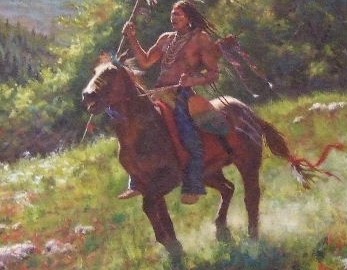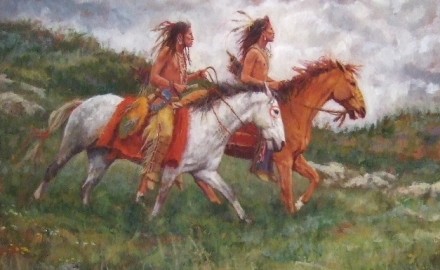In the chronicles of human history, countless cultures have emerged, matured, waned, and then finally disappeared. What perspectives of this world have died with them? James Ayers understands the inevitability of change and seeks to honor the customs and beauty of traditional cultures through his oil paintings. Learning Enhanced through Experience James’s paintings are more than just a slice of Native American history. They are the result of years of research combined with personal exploration and observation.
James has studied details of the cultures he portrays with an anthropologist’s eye, and marries his understanding of the struggles of modern Native cultures with his knowledge of their artifacts and rituals, in creating his canvases. Twenty Years of Research Shortly after graduating from the Rhode Island School of Design in 1991, James began a pattern of traveling, living, and working with indigenous peoples worldwide that continues to the present day. James traveled on foot with the semi-nomadic Samburu and Turkana people in Africa’s Great Rift Valley. He explored Native American reservations from Maine to Arizona, living with the Iroquois in the Northeast, the Sioux in the Great Plains, and the Hopi in the Southwest. James gleaned first-hand knowledge of the Arapaho Sundance Ceremony during a visit to the Wind River Reservation in Ethete, Wyoming. Most recently, James was invited to the Toadlena trading post region of the Navajo reservation in New Mexico to meet the sheepherders and weavers still living traditional lifeways.
James has sought first-hand experiences with dozens of tribal cultures, and with each relationship, he has gleaned insights that help him understand the historical material he incorporates into his art. Authentic Details Although the subjects in his works are fictionalized accounts rather than literal representations of specific events, every facet of James’ paintings is historically correct — from the style of a man’s plaited hair to the weapons used and even the motifs which decorate tipis, clothing, and shields. “Out of respect and honor for the people and cultures I paint, I strive to achieve the utmost honesty and authenticity I can attain in the artwork I create. This level of authenticity gives a much more believable and poignant impression to the viewer.”-James Ayers











